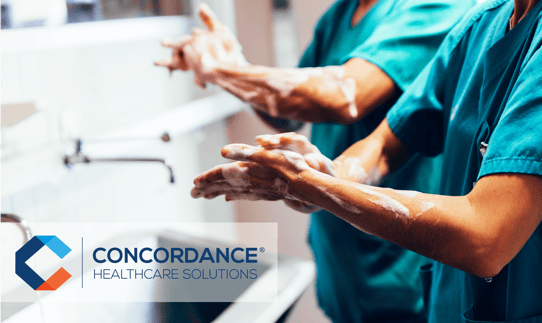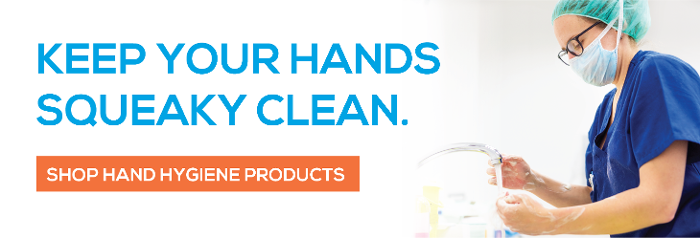It’s National Women’s Health Week! During this time, it’s important for healthcare providers to remind women of the important steps they can take to improve and sustain their health. Be sure to schedule your yearly primary care exams and checkups, which are important for preventative care. Share the information below with fellow healthcare...
More than Back Pain – The New World of Healthcare Safety

The month of June is designated as National Safety Month by the National Safety Council and serves as an annual reminder for employers to focus on reducing preventable injuries and death in the workplace. Now, more than ever, safety is crucial for our healthcare workers and their patients.
Hurting in Healthcare
According to the CDC, healthcare is the fastest-growing sector of the U.S. economy, employing over 18 million workers country-wide. These individuals face a large variety of risks in the workplace, from back injuries and needle sticks to hazardous drugs and exposure to harmful chemicals, not to mention the ever-growing lists of infectious agents that they may come in contact with. Healthcare workers continue to experience nonfatal injuries and illnesses at a rate higher than any other industry in the United States. While many of these instances are preventable, it is often times costly and cumbersome to implement the solutions necessary to reduce the employees’ exposure to hazards such as:
- Physical Vulnerabilities – With the consistent need for heavy manual lifting when transferring or repositioning patients, healthcare workers are vulnerable to developing Musculoskeletal disorders. If the national obesity pandemic is taken in to account, along with the increasing number of elderly patients, the weight that healthcare professionals are required to lift continues to increase year after year.
- Chemical Hazards – A staggering number of hazardous chemicals and drugs are present in the healthcare setting, including patient treatments, disinfectants, sterilization compounds, surgical smoke and specimen fixatives. These substances may pose an exposure risk to employees, patients and other individuals throughout the facility and since many healthcare workers tend to interact directly with these compounds, their risks are subsequently increased.
- Infectious Agents – Bacteria, fungi, viruses and parasites are all organisms that can cause infections or infectious diseases such as Influenza, Ebola, MRSA, SARS, Tuberculosis and even HIV/AIDS and Hepatitis. Due to the numerous activities involved in their line of work, healthcare professionals have an extremely high risk of coming into contact with these agents through cross contamination.
With a variety of solutions available to decrease physical hazards and lessen chemical exposure for healthcare workers, the main focus of today’s healthcare supply chain is to address the spread of infectious agents that are capable of causing world-wide disruption like the current COVID-19 pandemic.
Exposure Risks
Infection prevention measures have taken over the focus of many healthcare facilities across the country due to the recent pandemic. With the increased occupational risks of contracting SARS-CoV-2, healthcare providers work diligently to remain alert of the changing outbreak conditions and adjust their processes in order to keep their staff safe. Using OSHA’s occupational exposure risk pyramid, one can note the level of contamination hazard for different levels of healthcare workers.
- Low – Employees performing administrative duties in non-public areas of healthcare facilities, away from other staff members.
- Medium – Individuals working in busy staff areas within a healthcare facility and/or providing care to the general public who are not known or suspected COVID-19 patients.
- High – Workers that enter a known or suspected COVID-19 patient’s room and/or provide care for a known or suspected COVID-19 patient not involving aerosol-generating procedures.
- Very High – Staff members responsible for performing intubation, cough induction procedures, bronchoscopies or other aerosol-generating procedures on known or suspected COVID-19 patients and/or collecting or handling specimens from known or suspected COVID-19 patients.
It is important for all healthcare organizations to assess the hazards their employees may be exposed to; evaluate the risk of exposure; and select, implement, and ensure workers follow the proper procedures to prevent exposure.
Safe Work Practices
It is recommended by the CDC and OSHA that healthcare professionals perform as many tasks as possible in areas away from suspected or confirmed COVID-19 patients. If it is not vital to remain in the isolation area to complete a task, the employee should physically remove themselves from the space to limit exposure. They also recommend that workers and facilities do their best to limit touch contamination points, use extra caution when handling needles and ensure that there are systems in place to:
- Differentiate clean areas from potentially contaminated areas
- Handle waste and other potentially infectious materials
- Clean, disinfect, and maintain reusable equipment and PPE
It is not enough to simply have these types of policies in place; each facility should be frequently and thoroughly training their staff and communicating on the latest infection prevention procedures.
Staying safe in a healthcare environment and avoiding infectious agents also includes the proper use of PPE products and instituting administrative controls such as patient isolation and limiting staff members in those areas. Another safety measure, according to OSHA recommendations, is to use engineering controls to shield healthcare workers, patients and visitors from individuals that have been diagnosed with an infectious disease. This includes healthcare facilities installing airborne infection isolations rooms (AIIRs) with proper ventilation, which can be found in the Guidelines for Environmental Infection Control in Healthcare Facilities developed by the CDC and the Healthcare Infection Control Practices Advisory Committee (HICPAC).
Additional engineering controls useful in decreasing the spread of viruses are physical barriers that encourage proper social distancing for healthcare workers and patients. Partitions such as NOOK Huddle Pods, breath shields and desktop screens help to protect individuals in reception and waiting areas, administrative offices and nursing stations. Triage zones and isolations areas can be setup using mobile screens that are portable, retractable and hygienic, reducing the risks of exposure from patient to patient.
Proper Disinfection
As the country begins preparations for Opening up America Again, it is vital that healthcare facilities continue the increased, routine cleaning and disinfection procedures that have been implemented since the start of the pandemic. The EPA website provides a list of EPA-Registered disinfectantsthat have qualified for use against SARS-CoV-2 (the COVID-19 virus) under the emerging viral pathogens program. To ensure that areas are properly cleaned, these products should be utilized according to their label instructions and the CDC’s standard Guideline for Disinfection and Sterilization in Healthcare Facilities.
Employees responsible for cleaning and disinfection in healthcare settings may require PPE and/or other controls to protect them while performing their duties. These individuals will simultaneously be at risk of exposure to both the chemical hazards posed by disinfectants and from human blood, body fluids and other potentially infectious materials. In order to fully protect custodial personnel and other individuals working to disinfect medical facilities, healthcare providers should adapt to OSHA’s interim guidance for facilities with increased risk of occupational exposure.
Safety in Healthcare
The healthcare environment of today looks vastly different from past decades or even that of last year. With the ever-changing world, increased travel and connectivity, more intercontinental commerce and growing populations, the risk of exposure to new infectious diseases may continue to rise. However, as the nation works through this recent pandemic, many strides have been made in reducing those risks through new disinfection and PPE protocols, the installation of physical barriers to hinder person-to-person contact and instituting social distancing regulations within healthcare facilities. Ongoing education on these procedures and other safety training is a vital tool in order to combat the preventable injuries and illnesses that occur throughout the healthcare industry segment.
Concordance Healthcare Solutions focuses on understanding our customers’ unique situations so that we can properly support and provide for their needs during times of regular business and during emergency and pandemic situations. Contact us to discuss how we can assist in keeping your employees safe and preparing your facility for the unexpected.
Helping you stay in the know
Excluding certain types of skin cancer, breast cancer is the most common cancer in women in the United States, according to the Centers for Disease Control and Prevention. Women are strong, courageous and have created a community that has effectively changed the course of breast cancer. This month recognizes the electrified sororities of women and...
June is Men’s Health Month. This is an important time for healthcare providers to remind men of key factors that contribute to their overall health and how they can stay on top of certain health screenings. Below are some of the most common health risks for men.





